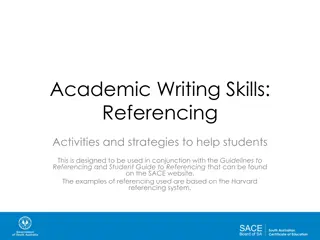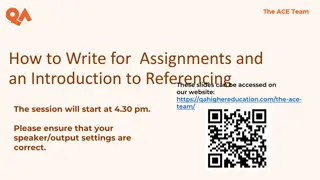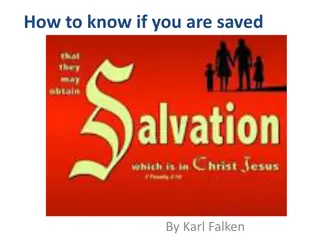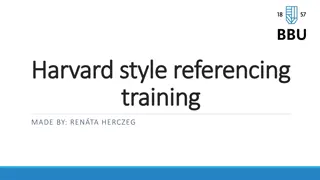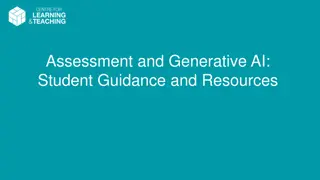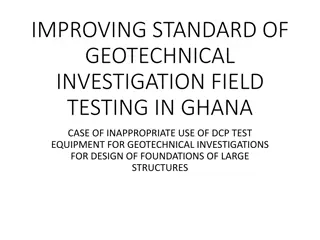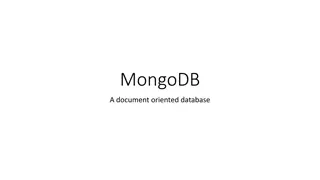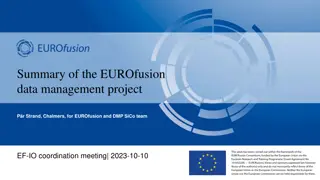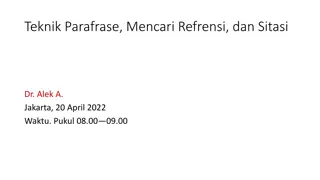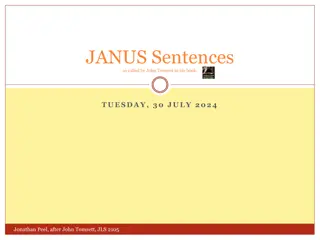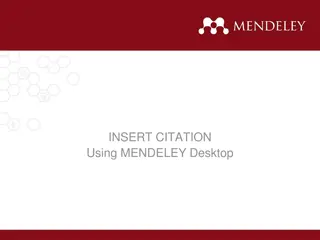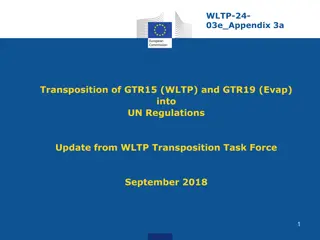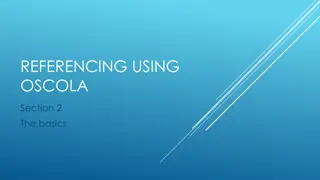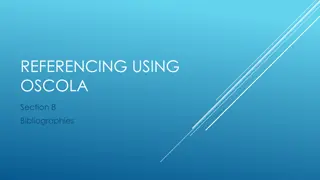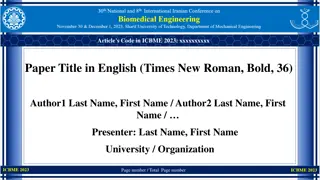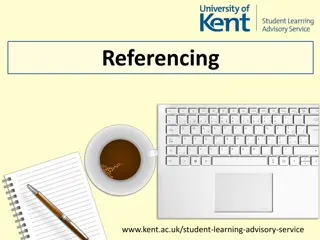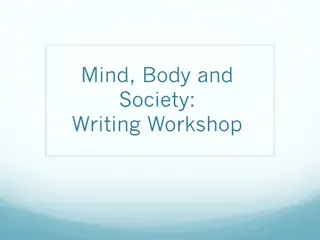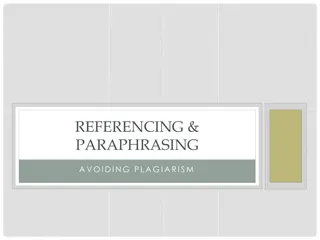
Understanding Referencing in Academic Writing
Explore the importance of referencing in academic writing, including different referencing systems, the purpose of reference lists and bibliographies, and why referencing is essential to avoid plagiarism and support your arguments. Learn how to use sources correctly to enhance credibility and reliability in your research.
Download Presentation

Please find below an Image/Link to download the presentation.
The content on the website is provided AS IS for your information and personal use only. It may not be sold, licensed, or shared on other websites without obtaining consent from the author. If you encounter any issues during the download, it is possible that the publisher has removed the file from their server.
You are allowed to download the files provided on this website for personal or commercial use, subject to the condition that they are used lawfully. All files are the property of their respective owners.
The content on the website is provided AS IS for your information and personal use only. It may not be sold, licensed, or shared on other websites without obtaining consent from the author.
E N D
Presentation Transcript
+ Referencing & academic writing
+What is it A reference is the link between what you have written and the evidence upon which your writing is basedConsider the following passage There are a number of different referencing systems All share one common feature In-text marker e.g. (Mosse 1996) The full reference Mosse G.L. 1996 Fascist Aesthetics and Society: Some Considerations Journal of Contemporary History 31:(2) 245- 252 Simon Whiffin September 2015
Simon Whiffin September 2015
+Reference list V Bibliography Reference list: a list of all the sources cited in your essay Bibliography: list of the sources that you have read but haven t cited sometimes referred to as background reading Annotated bibliography: A bibliography where each item is annotated with a short description that summarises the source. Simon Whiffin September 2015
+Why reference To acknowledge the authors of the sources you have used thereby helping you to avoid plagiarism Demonstrates that you have done the reading into the subject and have understood what you ve researched To support the arguments you make in your writing. (Remember it s unlikely you are an expert in the subject) To help the reader find the source if they want to view it. But be discriminating in your use of the literature Simon Whiffin September 2015
+Using sources correctly shows Evidence (you re unlikely to be the expert e.g. evidence to support breast feeding cultural V research) Credibility think about the sources you re using. Where is it published Traceability Authority Reliability Simon Whiffin September 2015
+A reference: the bare essentials Who wrote it What year was it published What s the title of the source Where can I find e.g. Title of the journal or the full URL of resource if it s online Simon Whiffin September 2015
+Where and when? References are needed in the written text where the material is first mentioned In a list at the end (reference list) When paraphrasing from the literature used to support your ideas When directly quoting from the literature (although keep this to an absolute minimum) Simon Whiffin September 2015
+Do you always need a reference though If you stating something that it accepted by all as a fact or what we might term common knowledge e.g. Health care provided by the NHS is free at the point of delivery You can honestly say that I didn t need to research anything to know that . For example you are making a reference to something in practice such as explaining why a patient might be catheterised. Williams and Carroll suggest the following test Simon Whiffin September 2015
+Do you always need a reference though If you write something that you can imagine someone asking questions like Really? Who says? Why s that? How do you know that? Then you ll chances are you found that out from somewhere so give a reference Simon Whiffin September 2015
+Citing in the text Beginning of a sentence: Hall and Ritchie (2009) suggested that .. Coulman (2012) describes the impact of In the middle of a sentence: It has been shown (Howatson-Jones 2010) that Research by Howes (2015) has identified that At the end of a sentence: A thorough review of these perspectives is provided (Corey 2005). The majority of Nurses are female (NMC 2012) Simon Whiffin September 2015
+In-text referencing example discusses that poor oral health in children can occur in any child and should not be ignored. Tooth decay in children can be prevented; however it is still a health concern, being one of the most frequent health needs in children .Despite Public Health England highlighting that the incidence of tooth decay in children aged five has decreased within the last twenty years, it has been estimated by that approximately 31 per cent of children aged five will have tooth decay. Simon Whiffin September 2015
+In-text referencing example Kierce et al (2016) discusses that poor oral health in children can occur in any child and should not be ignored. Tooth decay in children can be prevented; however it is still a health concern, being one of the most frequent health needs in children (Public Health England, 2014). Despite Public Health England (PHE, 2014) highlighting that the incidence of tooth decay in children aged five has decreased within the last twenty years, it has been estimated by NHS Choices (2012) that approximately 31 per cent of children aged five will have tooth decay. Simon Whiffin September 2015
+A journal reference Consider the following article This is referenced as Moorley C. and T. Chin 2015 Using social media for continuous professional development Journal of Advanced Nursing 71(4):713-717 Simon Whiffin September 2015
Name of journal Author s names Year of publication, volume, issue number and page numbers Title of article Simon Whiffin September 2015
+A book reference Consider the following text book Dimond B. 2011 Legal Aspects of Nursing 6th ed. Harlow: Pearson Education Limited Simon Whiffin September 2015
Book title Publisher Place of publication Year this edition published Edition number author Simon Whiffin September 2015
+A web reference Consider the following example NHS Choices 2016 Coeliac disease: Introduction. Available from http://www.nhs.uk/conditions/Coeliac- disease/Pages/Introduction.aspx [Accessed 24 September 2015] Simon Whiffin September 2015
Author or organisation Title of the resource Look for a date that the page was written or last updated. If there isn t a date put (no date) Full URL Simon Whiffin September 2015
+References to Reports, Guidelines etc This will cover things like clinical guidance from bodies like NICE, professional organisations like NMC and reports from or bodies like Department of Health Nursing and Midwifery Council 2015 The Code: Professional standards of practice and behaviour for nurses and midwives [Online] London: Nursing and Midwifery Council Available from http://www.nmc.org.uk/globalassets/sitedocuments/nmc- publications/revised-new-nmc-code.pdf [Accessed 24 September 2015] Simon Whiffin September 2015
+ The prevailing view of fascism is one of a nefarious ideology and yet, paradoxically during the 1930 s Nazi scientists were the first to establish a link between smoking and lung cancer. Indeed the Nazi s pursued a number of public health policies, such as the promotion of a healthily diet, that even by the standards of today would be regarded as progressive. (Davey Smith 2004). Whilst these public health initiatives grew out of the wider social hygiene movement that developed in the 19th century Aesthetics and what Mosse (1996) describes as the beauty of holiness played a pivotal role in what might be termed good health . Simon Whiffin September 2015
+References Williams K. and J. Carroll 2009 Referencing & Understanding Plagiarism Basingstoke: Plagrave Macmillian Simon Whiffin September 2015

